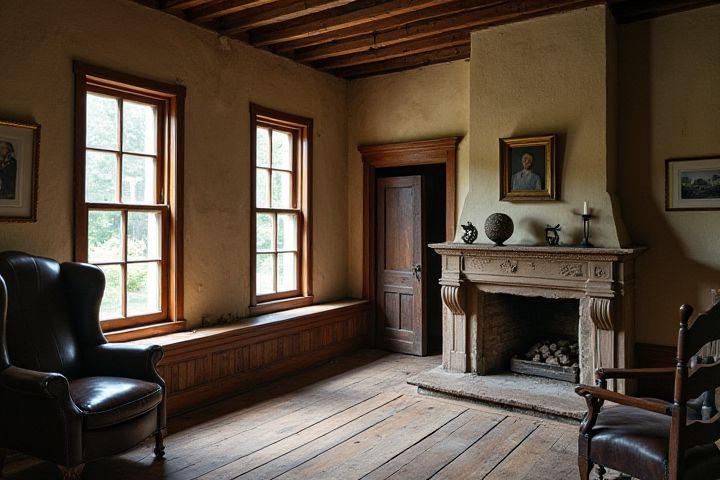
When evaluating a historic house, consider the architectural style and historical significance, which can reveal unique design elements and craftsmanship. Inspect structural integrity, ensuring that the foundation, roof, and walls are sound, as repairs can be costly. Assess original features like moldings, flooring, and windows, as they contribute to the home's authenticity and character. Investigate the property's provenance, including previous owners and its place in local history, which can enhance its value. Finally, verify any preservation restrictions, as these may affect renovations and alterations you might consider for your new home.
What To Look For In A Historic House
Structural integrity
When evaluating a historic house, prioritize the examination of its structural integrity, which is crucial for long-term stability and safety. Look for signs of foundation issues, such as cracks in walls or uneven floors, which may indicate serious structural problems. Inspect the roof for sagging or missing shingles, as these factors can lead to water damage and further deterioration. Additionally, check for wood rot or termite damage in beams and framing to assess the overall health of the property's structure.
Original architectural features
When evaluating a historic house, pay close attention to original architectural features such as moldings, doors, windows, and flooring, which can reveal the home's unique character. Look for craftsmanship details like hand-carved moldings or antique hardware, with many of these elements dating back to the home's initial construction. Verify the authenticity of the materials used; for example, original wood or brick can signify historical integrity. You should also check for any alterations or restorations that may affect the home's historical value, ensuring that the essence of the original design is preserved.
Historical significance
When evaluating a historic house, prioritize its historical significance by considering its architectural style, which may represent specific cultural movements or craftsmanship. Assess the home's age, as properties over 50 years old often qualify for historic designation, making them valuable for preservation efforts. Research the property's original owner or notable events associated with it, as these can enhance its historical appeal and contextual importance within a community. Finally, examine any renovations or restorations, ensuring they respect the home's integrity and contribute to its authentic narrative.
Preservation restrictions
When evaluating a historic house, it's crucial to consider various preservation restrictions that may apply to the property. These regulations often include guidelines mandated by local, state, or federal preservation agencies, detailing options for renovations, changes to the exterior, and the maintenance of original materials. You should also review any historic district designations, as these can influence property taxes and zoning regulations. Understanding the requirements and benefits of restoration incentives can significantly affect your decision-making and investment in the house.
Renovation costs
When evaluating a historic house for potential renovation, consider the structural integrity of the building, particularly the condition of the foundation, roof, and walls, which can significantly influence total costs. Expect renovation expenses to vary widely, typically ranging from $100 to $300 per square foot, depending on the complexity and type of materials used for restoration. Be aware of necessary permits and compliance with local preservation laws, which can add to your budget and timeline. Don't forget to factor in costs for updating essential systems like plumbing, electrical, and HVAC, as these can lead to substantial investment, sometimes exceeding $15,000.
Modern upgrades
When considering a historic house, focus on key modern upgrades that enhance functionality without compromising charm. Look for energy-efficient windows, which can reduce heating and cooling costs by up to 30%. Verify if it has modern plumbing and electrical systems that meet current safety standards, as outdated systems can lead to costly repairs. Additionally, check for smart home features like programmable thermostats or security systems that offer convenience and enhance your living experience.
Neighborhood context
When evaluating a historic house, consider its neighborhood context, including the architectural styles prevalent in the area, which can enhance your understanding of its historical significance. Research the neighborhood's development timeline, as houses built within a specific period may reflect collective design trends and construction techniques from that era. Pay attention to local landmarks or historical sites, as their proximity can influence property value and your appreciation of the home's cultural context. Finally, investigate the community's preservation efforts, as areas committed to maintaining architectural integrity often attract buyers who value historic authenticity.
Maintenance requirements
When evaluating a historic house, assess the condition of the roof and the quality of roofing materials, as replacements can cost upwards of $15,000. Examine the foundation for cracks and moisture issues; repairs may range from $5,000 to $30,000 depending on severity. Look for signs of pest infestations, which could lead to costly remediation, averaging around $1,500. Finally, evaluate the state of plumbing and electrical systems, as upgrades for code compliance can exceed $10,000 in expenses.
Historical records
When evaluating a historic house, prioritize the availability and authenticity of historical records, including property deeds, tax assessments, and renovation permits, which can provide crucial insights into the home's provenance. Examine architectural plans and blueprints that may reveal design changes over time, reflecting the property's evolution. Review historical newspaper archives to uncover stories or events associated with the house and its previous occupants, which can enrich your understanding. Engaging with local historical societies or libraries can also yield valuable documents and resources that deepen your appreciation of the house's significance.
Investment potential
When evaluating a historic house for investment potential, consider the property's location, as homes in desirable neighborhoods typically appreciate more significantly, often seeing increases of 5-10% annually. Assess the structure's condition and any renovations needed; properties requiring extensive work can lead to higher costs, potentially diminishing your return on investment. Investigate local zoning laws and regulations regarding historic properties, which can affect your ability to renovate and may grant tax incentives, further enhancing your financial outlook. Lastly, research the historical significance of the house, as properties with rich narratives or architectural uniqueness often attract premium interest, providing you with a substantial resale value.
